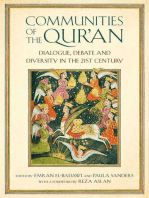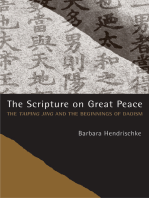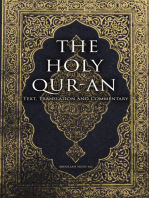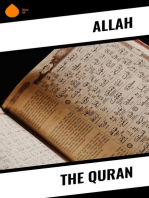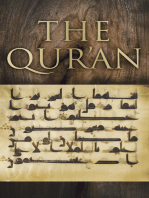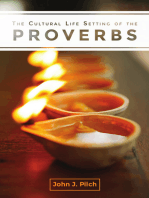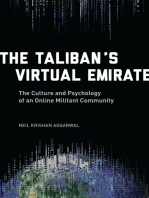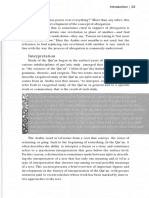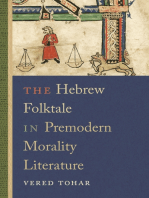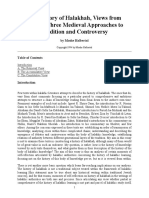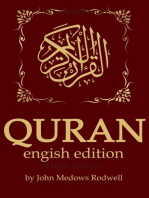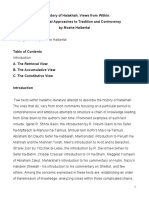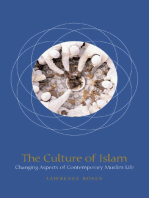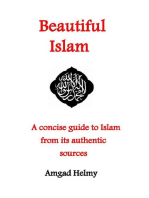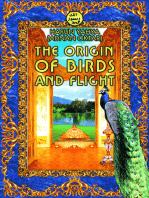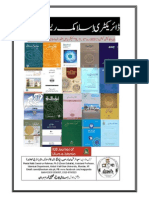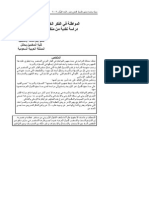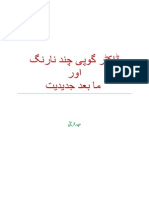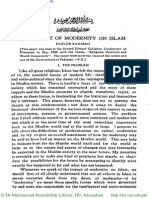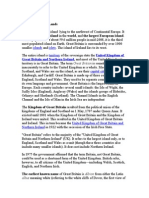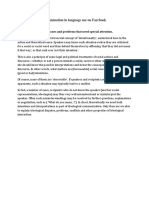Documente Academic
Documente Profesional
Documente Cultură
© DR Muhammad Hamidullah Library, IIU, Islamabad. Http://iri - Iiu.edu - PK
Încărcat de
Syed Mateen AhmedTitlu original
Drepturi de autor
Formate disponibile
Partajați acest document
Partajați sau inserați document
Vi se pare util acest document?
Este necorespunzător acest conținut?
Raportați acest documentDrepturi de autor:
Formate disponibile
© DR Muhammad Hamidullah Library, IIU, Islamabad. Http://iri - Iiu.edu - PK
Încărcat de
Syed Mateen AhmedDrepturi de autor:
Formate disponibile
BOOK REVIEWS
114
the increasing marginalization of the traditional modes of life, and the
unreserved embrace of European culture and values by the Egyptian elite. Yet,
the sweet nostalgia by which Baraka re-constructs images of Cairene exclusive
clubs, city quarters, theatres and parliament (which was also a sort of exclusive
institution), conceals other vital dimensions of the life and works of the
Egyptian upper class. To a certain extent, Baraka efficiently documents what
she calls the serious limitations of the upper classs attitudes towards
democracy and issues of social reform, including the fear from the spread of
education among the peasants, the strong beliefs among the landed stratum of
its inherent right to rule, and the slow development of democracy and political
participation. What she is obviously reluctant to mention was the sharp
disparity between the standards of living of the pashas and the ordinary
Egyptian, the brutality and exploitation that characterized the relations
between the 0.5 percent and the rest, 11 and the vast gap that separated the
cultural milieu of the upper class from the daily life of the vast majority of
people.
Todays Egypt seems to be entering a new phase of social polarization and
differentiation. After a short period of socially oriented experiment (which,
however badly it is now portrayed, did attempt to establish a more inclusive
society), the distance between the wealthy few and the poor many is on the
increase. As the nouveau riche embrace the American culture in a demeaning
manner, the majority of Egyptians seem to sink deeper and deeper, struggling
against decaying urban quarters, dehumanizing public transport and a
dysfunctional system of education. If only for this, and despite its
shortcomings, Barakas book should become necessary reading.
^ ^ ^
Irfan Ahmad Khan. Insight into the Qurn. New Dehli: Genuine
Publications & Media, 1999. Pp. 816. Paperback. ISBN 81-85220-58-1.
Price: $ 60.00.
This book is a commentary on the first two srahs of the Qurn. It consists of
an introductory note of 33 pages, the explanation of Srah al-Ftiah
On the situation of the Egyptian peasants during the first half of the twentieth century, see
the observations of Russell Pasha in his Egyptian Service, 19021946 (London: John Murray,
1949), 3042.
11
Dr Muhammad Hamidullah Library, IIU, Islamabad.
http://iri.iiu.edu.pk/
BOOK REVIEWS
115
(16 pages), and Srah al-Baqarah (742 pages), and annexures comprising of
16 pages. The text is divided into sections of varying length, each bearing a
single subject which appears along with word by word as well as paraphrased
translations. The translation is generally very good and fluent, and is followed
by explanatory notes. Thus the reader can easily comprehend the meanings of
the text with the aid of the two types of translation.
The author aims at understanding the text with a modern mind and at
seeing the Divine Book as encountering the situations we face today. He is of
the opinion that the true revival of the ummah is contingent upon the
scholars effort to build their direct relationship with the Divine Book. We
need Qurnic education on a grass-roots level...... This book is part of a
mission which wants the ummah back to the Qurn, he says (p. 24). Keeping
his stated mission in view, the learned author has compiled the results of his
own efforts at understanding the two srahs to serve as a model for other
students of the Qurn.
The learned author has presented the results of his contemplations and
reflections in such manner as if he were a teacher instructing his students how
to study and analyze, and how to reflect and arrive at right conclusions. In fact
he holds his readers finger to walk along with him in order to facilitate the
latters task. Even then the presentation is cumbersome and in the opinion of
this reviewer an uninitiated student of the Qur n will not find it easy to
grasp, because it is burdened a bit too much with Arabic words and crossreferences.
Every good commentator of the Qurn formulates certain principles for
his study and prescribes procedures to arrive at his conclusions. The learned
author, too, has devised elaborate procedures to understand the Qur n and
has faithfully followed them. According to him, every srah is a complete
discourse and should be understood as such. It is very systematically organized
and bears a central theme. It is after gaining an understanding of this central
theme that one can appreciate the import of each verse. Since every srah is
coherent, well knit and systematically organized, the literary context of each
verse must be kept in mind, as the neglect of it may cause misunderstanding
and may even lead to the distortion of the Divine Message. The author
upholds the concepts pioneered by amd al-Dn Farh (d. 1349/1930) and
followed by Amn Asan Il (d. 1418/1997) in his commentary titled
Tadabbur-i Qurn. The author acknowledges the valuable work done by these
scholars and benefits from their researches in his book.
According to the author the fundamental principles in the understanding
of the Qurn are the following: (i) that the Qur n should be approached in
the right frame of mind and with full conviction that when one reads the
116
BOOK REVIEWS
Qurn one is going to study the Revealed Guidance in Divine Words
(RGDW); (ii) that one part of the Qur n explains another part; and (iii) that
there is no triviality in the Qur n. The author has taken pains to analyze each
srah so as to understand its internal structure and to arrive at the central
theme around which the srah revolves. He has extensively used the abovementioned tools to produce an excellent explanation of the srahs selected for
the study. He proves his stance by means of numerous cross-references
gathered from all over the Qurn.
Here and there one finds very long notes, each spread over several pages,
on some of the themes, such as ibdah, idq (truthfulness), il, marf,
conflict between Truth and Falsehood, etc. These are self-contained pieces of
research. The note on ibdah (8 pages), for example, includes all types of
worship, such as alh (Prayer), dhikr (remembrance), du (supplication)
adaqt (charities) and zakh. The note on il is based on the occurrence of
this theme in Srahs al-Arf, al-Rm, al-Nal, al-Shr and al-ujurt.
Although these notes are valuable as pieces of research, they distract the
readers attention from the immediate subject under study.
The learned author is of the view that the Qur n, in its capacity as
RGDW, addresses all future situations and, therefore, it is a mistake to think
that any situation which the Prophet (peace be on him) or his people faced,
occasioned any part of the Divine Book (p. 26). In my opinion, the correct
approach is that although the situations faced by the Prophet (peace be on
him) and his Companions occasioned the revelation of the Qur n, the Book
being RGDW, addresses those situations for all times to come. The effect of
misconception manifests itself when the author does not identify the groups
alluded to in Srah al-Ftiah as maghb alayhim and lln and those in
Srah al-Baqarah, verses 8 to 20. Even the three Jewish tribes of Mad nah, who
are addressed in al-Baqarah time and again as the Children of Israel, have not
been named.
There are references to numerous episodes from the history of the
Israelites in Srah al-Baqarah but the author refrains from explaining them in
the light of the Old Testament, saying that his main interest lies in a
conceptual study only. This reviewer thinks that lack of historical details has
made the study obscure. The actual perspective of the episodes would have
conveyed the message better.
The application of the principles of tafsr stated by the author has been
faulty in some respects or, perhaps, his mind is obsessed by certain notions,
when he defines (i) Tawd as a programme to liberate human beings from
slavery of each other; (ii) Shirk as lordship of Man over Man leading to mutual
exploitation and corruption within human society; (iii) The mnic movement
BOOK REVIEWS
117
of the Prophets as a peaceful campaign against the injustice deeply rooted in
the social system. In fact, what he has described are not tawd, shirk or mnic
movement themselves, but their effects on the society.
The Qurn states that initially human beings were a single ummah but
later they disputed the concept of tawd and became divided into factions.
Then Allah sent the prophets to bring the dissidents back to tawd. This
rationale of the institution of prophethood is clearly stated in the Qur n. The
author puts it in the following words:
In the beginning human beings were one community. There was no internal
conflict, no mutual exploitation (even no distinction between upper/super and
lower/inferior strata of society in spite of differences among the people in power,
prestige, wealth, knowledge, etc.). As one family of the servants of one God, they
were mutually concerned. They shared their resources and had great mutual
respect. They were all trying their best to do their mutual duties as assigned by
the Lord. But slowly Shirk crept in and very soon human beings were divided by
the lordship of Man over Man. There was injustice everywhere. The rich, instead
of sharing with the poor, started sucking their blood. Those who had power and
prestige in human society further humiliated the downtrodden and the weak.
Human beings were no longer one family of the fellow servants of their
Lord......... It was at this point that God started sending his messengers and
prophets to make them one community again (pp. 541542).
The author abhors the concept of abrogation of certain verses of the
Qurn, although it is not something undesirable. It simply means that some
of the commandments were revealed by stages for the convenience of the
believers. He insists that verse 180 of Srah al-Baqarah was not abrogated by
the verses 1112 of Srah al-Nis. The latter-mentioned verses fixed shares for
the parents while the former called for bequest in their favour. The author is
silent on the issue of reconciling the apparent difference between the two
commandments. Similarly, he holds that verse 184 of Srah al-Baqarah
addresses those who are permanently invalidated for fasting and allows them
to feed a poor person for every day that they miss their fast. Thus it is not
abrogated by verse 185. Accordingly, he translates the verse 184 as follows:
(Observe fasting over) a fixed number of days, but if any of you is ill, or on a
journey, the prescribed number (should be made up) from later days. For
those who can hardly do it is a ransom the feeding of a poor person and
whoever does good willingly it is better for him. And it is better for you that
you fast, if only you know.
The translation of the phrase yuqnahu in this verse as who can hardly
do it is questionable because every verb falling in bb ifl does not, as a rule,
convey two meanings negating one another. In fact the above meaning is not
BOOK REVIEWS
118
proved by the actual linguistic usage among the Arabs. Secondly, if the verse
were addressing permanently invalid persons, why did it ask them to do good
willingly but it was better for them to fast?
The learned author skips over some of the verses. He has not offered any
explanation of Alif Lm Mm or the verse 116, which mentions the People of
the Book as saying that Allah has taken to Him a son. He states that al-Masjid
al-Aq was made the qiblah for the Muslims after the Hijrah. Historically, this
is not correct and the Prophet (peace be on him) used to face towards the said
mosque while he was in Makkah before the Hijrah.
There are numerous mistakes of proofreading. A long paragraph at p. 31
appears twice. The annexures contain important Arabic or hybrid words
used as terms (pp. 79497) and an index of important themes of reflection
(pp. 798808).
Khalid Masud
^ ^ ^
N.A. Newman. Muhammad, the Quran and Islam. Hatfield, PA:
Interdisciplinary Biblical Research Institute, 1996. Pp. 425. Paperback.
ISBN 0-944788-86-6. No price given.
It must be noted from the outset that Muhammad, the Quran and Islam is
unfortunately not a serious academic work. It is driven by a highly partisan
agenda and its tone is negative, even condescending in its treatment of
traditional Muslims claims made for the Qur n and the Prophet;
interestingly enough, he is equally dismissive of some of the more recent
Western scholarship on early Islam. For him W. M. Watt is much too evenhanded in his treatment of the Qur n and Muammad. Although he nowhere
acknowledges the point, the authors orientation is clearly Christian, but it
should also be noted that the Christianity in question is of a decidedly narrow
sort. His orientation is apparent throughout the work and it colours both his
approach and the conclusions to which he arrives.
Newman insists on applying what might be called a source-critical
approach to the Qurn and objects to scholars like W. M. Watt who have
argued that in the case of the Qur n, at least, the question of sources is largely
irrelevant to an understanding of the text as it stands. Newman, by contrast,
S-ar putea să vă placă și
- Communities of the Qur'an: Dialogue, Debate and Diversity in the 21st CenturyDe la EverandCommunities of the Qur'an: Dialogue, Debate and Diversity in the 21st CenturyEvaluare: 1 din 5 stele1/5 (1)
- Surah Nas Tafsir Al-Mizan - An Exegesis of The Holy Quran by The Late Allamah Muhammad Hussain TabatabaiDocument6 paginiSurah Nas Tafsir Al-Mizan - An Exegesis of The Holy Quran by The Late Allamah Muhammad Hussain TabatabaiSyed Xishaan MosavieÎncă nu există evaluări
- The Cambrian Evidence that Darwin Failed to ComprehendDe la EverandThe Cambrian Evidence that Darwin Failed to ComprehendÎncă nu există evaluări
- Esoteric Islam: A Hermetic Perspective on Islamic TraditionsDe la EverandEsoteric Islam: A Hermetic Perspective on Islamic TraditionsEvaluare: 3.5 din 5 stele3.5/5 (2)
- Al-Ghazzali's Mishkat al-Anwar: (The Niche for Lights)De la EverandAl-Ghazzali's Mishkat al-Anwar: (The Niche for Lights)Încă nu există evaluări
- Al-Mizan (Al I Imran)Document623 paginiAl-Mizan (Al I Imran)jaamdoctor100% (1)
- People of the Book: Canon, Meaning, and AuthorityDe la EverandPeople of the Book: Canon, Meaning, and AuthorityEvaluare: 4 din 5 stele4/5 (2)
- The Scripture on Great Peace: The Taiping jing and the Beginnings of DaoismDe la EverandThe Scripture on Great Peace: The Taiping jing and the Beginnings of DaoismEvaluare: 5 din 5 stele5/5 (1)
- Development of Muslim Theology, Jurisprudence, and Constitutional TheoryDe la EverandDevelopment of Muslim Theology, Jurisprudence, and Constitutional TheoryÎncă nu există evaluări
- The Holy Quran: Text, Translation and CommentaryDe la EverandThe Holy Quran: Text, Translation and CommentaryÎncă nu există evaluări
- The Wisdom Literature: Interpreting Biblical Texts SeriesDe la EverandThe Wisdom Literature: Interpreting Biblical Texts SeriesEvaluare: 3.5 din 5 stele3.5/5 (5)
- The Must Know Guide to the Qur'an for the Western WorldDe la EverandThe Must Know Guide to the Qur'an for the Western WorldEvaluare: 2.5 din 5 stele2.5/5 (2)
- Death of the Darwinist Dajjal System «The End of 150 Years of Darwinist Deception»De la EverandDeath of the Darwinist Dajjal System «The End of 150 Years of Darwinist Deception»Încă nu există evaluări
- The Holy Qur-an: Text, Translation and CommentaryDe la EverandThe Holy Qur-an: Text, Translation and CommentaryÎncă nu există evaluări
- Concepts of Quran Toshihiko IzutsuDocument5 paginiConcepts of Quran Toshihiko IzutsuMudassar Mian100% (1)
- Eerdmans Commentary on the Bible: Ezra and NehemiahDe la EverandEerdmans Commentary on the Bible: Ezra and NehemiahEvaluare: 3.5 din 5 stele3.5/5 (6)
- Opening the Qur'an: Introducing Islam's Holy BookDe la EverandOpening the Qur'an: Introducing Islam's Holy BookÎncă nu există evaluări
- The Taliban's Virtual Emirate: The Culture and Psychology of an Online Militant CommunityDe la EverandThe Taliban's Virtual Emirate: The Culture and Psychology of an Online Militant CommunityÎncă nu există evaluări
- LECTURA 4. John Kaltner. Introducing The Qur An. For Today S ReadersDocument19 paginiLECTURA 4. John Kaltner. Introducing The Qur An. For Today S ReadersFERRNANDOÎncă nu există evaluări
- How to Read the Qur'an: A New Guide, with Select TranslationsDe la EverandHow to Read the Qur'an: A New Guide, with Select TranslationsEvaluare: 5 din 5 stele5/5 (1)
- Women in the Qur'an: An Emancipatory ReadingDe la EverandWomen in the Qur'an: An Emancipatory ReadingEvaluare: 4.5 din 5 stele4.5/5 (6)
- 742 - Ajiss21-1 - Book Reviews - Mulla Sadra The Elixir of The GnosticsDocument4 pagini742 - Ajiss21-1 - Book Reviews - Mulla Sadra The Elixir of The GnosticskhurshidqÎncă nu există evaluări
- The Rhetoric of the Babylonian Talmud, Its Social Meaning and ContextDe la EverandThe Rhetoric of the Babylonian Talmud, Its Social Meaning and ContextÎncă nu există evaluări
- A Basic Guide to Understanding the Qur'an: Based on Direct Interpretation of Verses from the Qur'anDe la EverandA Basic Guide to Understanding the Qur'an: Based on Direct Interpretation of Verses from the Qur'anÎncă nu există evaluări
- The great book of Islamic Civilization on Qua'ranic ExegesisDe la EverandThe great book of Islamic Civilization on Qua'ranic ExegesisÎncă nu există evaluări
- Class 4 - HalbertalDocument12 paginiClass 4 - HalbertalAriel JusidÎncă nu există evaluări
- Preaching Islamic Renewal: Religious Authority and Media in Contemporary EgyptDe la EverandPreaching Islamic Renewal: Religious Authority and Media in Contemporary EgyptÎncă nu există evaluări
- The Analects: Conclusions and Conversations of ConfuciusDe la EverandThe Analects: Conclusions and Conversations of ConfuciusÎncă nu există evaluări
- Quran (Al-Qur'an)De la EverandQuran (Al-Qur'an)J.M. RodwellÎncă nu există evaluări
- Quran Research PaperDocument8 paginiQuran Research Paperp0zikiwyfyb2100% (1)
- Qur'an Linguistic MiracleDocument4 paginiQur'an Linguistic Miraclehaqq92Încă nu există evaluări
- Halbertal The History of HalakhahDocument27 paginiHalbertal The History of HalakhahqwentionÎncă nu există evaluări
- Misquoting Muhammad: The Challenge and Choices of Interpreting the Prophet's LegacyDe la EverandMisquoting Muhammad: The Challenge and Choices of Interpreting the Prophet's LegacyEvaluare: 4 din 5 stele4/5 (8)
- The Culture of Islam: Changing Aspects of Contemporary Muslim LifeDe la EverandThe Culture of Islam: Changing Aspects of Contemporary Muslim LifeÎncă nu există evaluări
- Lughat Ul QuranDocument6 paginiLughat Ul QuranShahzad ShameemÎncă nu există evaluări
- Culture of Encounters: Sanskrit at the Mughal CourtDe la EverandCulture of Encounters: Sanskrit at the Mughal CourtÎncă nu există evaluări
- Jaddedtar Urdu Ghazal-Arshad Mahmood NashadDocument44 paginiJaddedtar Urdu Ghazal-Arshad Mahmood NashadSyed Mateen AhmedÎncă nu există evaluări
- Directory Islamic Research JournalsDocument14 paginiDirectory Islamic Research JournalsسعیدیاتÎncă nu există evaluări
- Namak Mirch - Niaz SawatiDocument10 paginiNamak Mirch - Niaz SawatiSyed Mateen AhmedÎncă nu există evaluări
- DeewanHafiz 1Document310 paginiDeewanHafiz 1Syed Mateen AhmedÎncă nu există evaluări
- Lahja e Khanda Ijaz UbaidDocument28 paginiLahja e Khanda Ijaz UbaidSyed Mateen AhmedÎncă nu există evaluări
- Islam Ki BatiyaanDocument604 paginiIslam Ki BatiyaanSyed Mateen AhmedÎncă nu există evaluări
- علماء الأمة في مواجهة التحديات المعاصرة في ضوء القرآن الكريمDocument24 paginiعلماء الأمة في مواجهة التحديات المعاصرة في ضوء القرآن الكريمnuckcheddyÎncă nu există evaluări
- Shahast HussainDocument79 paginiShahast HussainSyed Mateen AhmedÎncă nu există evaluări
- Islami Adab Iqbal-Tahseen FiraqiDocument26 paginiIslami Adab Iqbal-Tahseen FiraqiSyed Mateen AhmedÎncă nu există evaluări
- الإسلام وحوار الحضاراتDocument18 paginiالإسلام وحوار الحضاراتalhiwartodayÎncă nu există evaluări
- Citizenship in WestDocument45 paginiCitizenship in WestSyed Mateen AhmedÎncă nu există evaluări
- Status of Individual in Islam - Fazl Rahman DRDocument12 paginiStatus of Individual in Islam - Fazl Rahman DRSyed Mateen AhmedÎncă nu există evaluări
- Iqbal Tafheem MughalttayDocument17 paginiIqbal Tafheem MughalttaySyed Mateen AhmedÎncă nu există evaluări
- Revies On BooksDocument3 paginiRevies On BooksSyed Mateen AhmedÎncă nu există evaluări
- Quranic Concept of God-Fazlur Rahman DRDocument19 paginiQuranic Concept of God-Fazlur Rahman DRSyed Mateen AhmedÎncă nu există evaluări
- Notes Fazl RahmanDocument2 paginiNotes Fazl RahmanSyed Mateen AhmedÎncă nu există evaluări
- Engagement and IntegrationDocument109 paginiEngagement and IntegrationSyed Mateen AhmedÎncă nu există evaluări
- Mabaad Jadeediat or Gopi Chand NarangDocument142 paginiMabaad Jadeediat or Gopi Chand NarangSyed Mateen AhmedÎncă nu există evaluări
- Naseer ToosiDocument74 paginiNaseer ToosiSyed Mateen AhmedÎncă nu există evaluări
- Qita Kalami - Anwar MasoodDocument90 paginiQita Kalami - Anwar MasoodSyed Mateen AhmedÎncă nu există evaluări
- Some Refleections Fazlur Rahman DRDocument18 paginiSome Refleections Fazlur Rahman DRSyed Mateen AhmedÎncă nu există evaluări
- Currents of Religious ThoughtDocument7 paginiCurrents of Religious ThoughtSyed Mateen AhmedÎncă nu există evaluări
- A Jerman Book Review - Fazlrahman DRDocument2 paginiA Jerman Book Review - Fazlrahman DRSyed Mateen AhmedÎncă nu există evaluări
- Social Change and Early Sunnah: The Problem Before UsDocument12 paginiSocial Change and Early Sunnah: The Problem Before UsSyed Mateen AhmedÎncă nu există evaluări
- A Jerman Book Review - Fazlrahman DRDocument2 paginiA Jerman Book Review - Fazlrahman DRSyed Mateen AhmedÎncă nu există evaluări
- The Impact of Moderinity On IslamDocument16 paginiThe Impact of Moderinity On IslamSyed Mateen AhmedÎncă nu există evaluări
- Riba and Interest - Fazlur RahmanDocument43 paginiRiba and Interest - Fazlur RahmanSyed Mateen Ahmed91% (11)
- AbstractsDocument2 paginiAbstractsSyed Mateen AhmedÎncă nu există evaluări
- Muasir Tahzeebi Fikr or Iqbal - TanoliDocument15 paginiMuasir Tahzeebi Fikr or Iqbal - TanoliSyed Mateen AhmedÎncă nu există evaluări
- India Will Not Become A Great Power byDocument13 paginiIndia Will Not Become A Great Power bymanchorusÎncă nu există evaluări
- Bill of Rights 1688 (1689)Document3 paginiBill of Rights 1688 (1689)Anderson CandeiaÎncă nu există evaluări
- SAAF General Application Form 2022 IntakeDocument1 paginăSAAF General Application Form 2022 IntakeGoitsemodimo SennaÎncă nu există evaluări
- Osmena V OrbosDocument1 paginăOsmena V OrbosMichelle DecedaÎncă nu există evaluări
- Business Law D6Document234 paginiBusiness Law D6Dixie Cheelo50% (2)
- Sociolinguistics - Language Endangerment and Its Maintenance (Whorfyan)Document1 paginăSociolinguistics - Language Endangerment and Its Maintenance (Whorfyan)Wanti AmeliaÎncă nu există evaluări
- PAYNE, Stanley G. Fascism. Comparison and DefinitionDocument243 paginiPAYNE, Stanley G. Fascism. Comparison and DefinitionClara Lima100% (1)
- MC CarthyDocument1 paginăMC Carthyarghya_bi108Încă nu există evaluări
- Lekhnath Khanepani: Due Bill of Bill Amount Discount Penalty Payable AmountDocument1 paginăLekhnath Khanepani: Due Bill of Bill Amount Discount Penalty Payable AmountPujan PandeyÎncă nu există evaluări
- ItalyDocument3 paginiItalyasdfseÎncă nu există evaluări
- David K. Fieldhouse - Kurds, Arabs and Britons - The Memoir of Col. W.A. Lyon in Kurdistan, 1918-1945 (2002, I. B. Tauris)Document257 paginiDavid K. Fieldhouse - Kurds, Arabs and Britons - The Memoir of Col. W.A. Lyon in Kurdistan, 1918-1945 (2002, I. B. Tauris)Ahmet DemirÎncă nu există evaluări
- American Definition EssayDocument2 paginiAmerican Definition EssayDenise Nicole100% (1)
- The Forum Gazette Vol. 3 No. 13 July 5-19, 1988Document16 paginiThe Forum Gazette Vol. 3 No. 13 July 5-19, 1988SikhDigitalLibraryÎncă nu există evaluări
- Values-Education - Terrorism - FINALDocument29 paginiValues-Education - Terrorism - FINALBebe rhexaÎncă nu există evaluări
- CorwinDocument8 paginiCorwinPeopleNewspapersDallasÎncă nu există evaluări
- Reading in Phillipine History PDFDocument12 paginiReading in Phillipine History PDFjohn alester cuetoÎncă nu există evaluări
- Feudalism and Manorial IsmDocument28 paginiFeudalism and Manorial Ismjhfletcher100% (1)
- Oswal Case StudyDocument7 paginiOswal Case StudyayeshaÎncă nu există evaluări
- Artifactone KeyinsighttwoDocument7 paginiArtifactone Keyinsighttwoapi-527309735Încă nu există evaluări
- 2011 Buckingham JF PHDDocument397 pagini2011 Buckingham JF PHDMidnight_12Încă nu există evaluări
- The Role of Customary International Law in The 21st CenturyDocument8 paginiThe Role of Customary International Law in The 21st CenturySejal PatidarÎncă nu există evaluări
- Civil Rights Performance TaskDocument5 paginiCivil Rights Performance Taskapi-295086698Încă nu există evaluări
- Congressional Debates of The 14th AmendmentDocument401 paginiCongressional Debates of The 14th AmendmentJoe Reeser100% (9)
- Britain The Four LandsDocument21 paginiBritain The Four LandsEduard PustianuÎncă nu există evaluări
- Film Insurance Form-WebsiteDocument4 paginiFilm Insurance Form-Websiteapi-286624549Încă nu există evaluări
- Philippines Halal Certification Bodies (HCB)Document2 paginiPhilippines Halal Certification Bodies (HCB)Marshae Chaclag PasongÎncă nu există evaluări
- Syllabus NSTP 1Document14 paginiSyllabus NSTP 1sxy愛.Încă nu există evaluări
- British Leyland: What The Prime Minister Thought (Part Three)Document248 paginiBritish Leyland: What The Prime Minister Thought (Part Three)danielharrison1100% (1)
- C. The Effects of Discrimination in Language Use On FacebookDocument2 paginiC. The Effects of Discrimination in Language Use On FacebookDracula VladÎncă nu există evaluări
- Briefing Note On Mental Health (Amendment) (No.2) Bill 2017 - 03.07.17Document2 paginiBriefing Note On Mental Health (Amendment) (No.2) Bill 2017 - 03.07.17Gateway ProjectÎncă nu există evaluări
